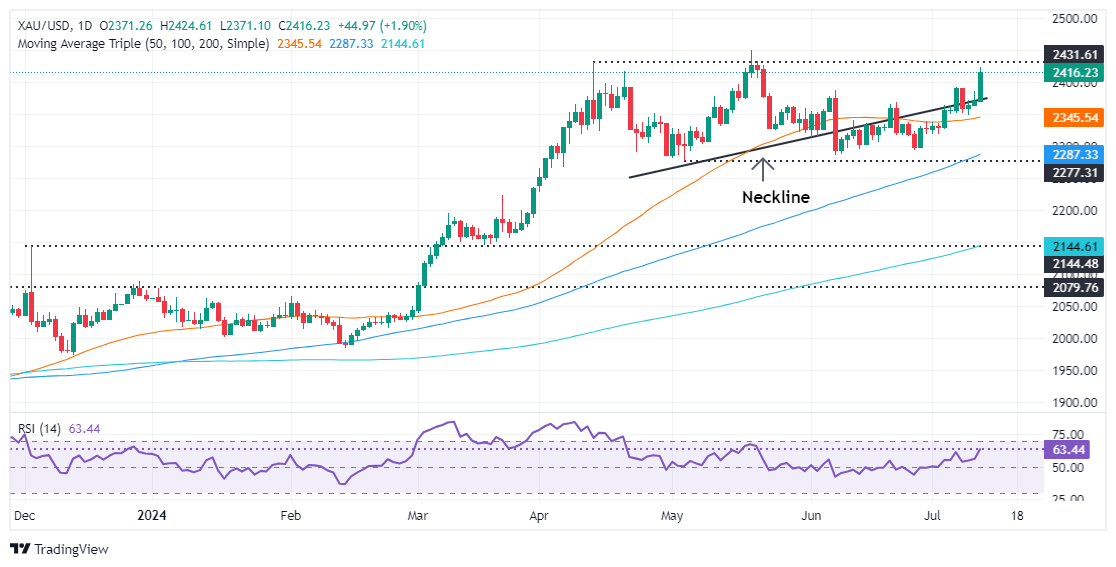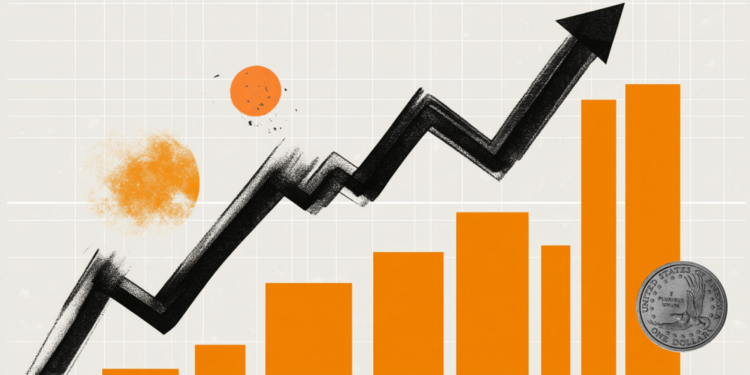- Gold surges above $2,400 as softer US CPI fuels hopes for Fed rate cuts in 2024.
- The 10-year US Treasury yield fell 10 basis points to 4.187%, increasing the attractiveness of gold.
- CME FedWatch tool shows 85% chance of a September rate cut; US Dollar Index drops to 104.48.
Gold prices surged sharply during the North American session on Thursday after the release of the US Consumer Price Index (CPI) opened the door for the Federal Reserve (Fed) to cut borrowing costs. Therefore, US Treasury yields plunged, a tailwind for the precious metal. XAU/USD is trading at $2,414, up over 1.80% after bouncing off daily lows of $2,371.
Market sentiment turned negative as the S&P 500 and Nasdaq 100 fell sharply, while the Dow Jones Industrial Average advanced. U.S. yields are collapsing with the 10-year Treasury note yield down 10 basis points to 4.187%.
Data from the US Bureau of Labor Statistics (BLS) revealed that consumer prices deflated in June. Excluding volatile items such as food and energy, the so-called core also declined, rekindling hopes that the Fed could cut rates in 2024.
The CME FedWatch tool shows an 85% chance of a quarter-point rate cut in September, up from 70% on Wednesday.
The December 2024 federal funds rate futures contract implies the Fed will ease policy by 49 basis points (bps) by year-end, up from 39 yesterday.
Other data showed the labor market remains robust as the number of Americans filing for unemployment benefits fell short of consensus and was lower than the previous reading.
Today’s US data paint a balanced picture: inflation is declining while employment remains strong, with no signs of an imminent recession.
Meanwhile, the US Dollar Index (DXY), which tracks the value of a basket of six currencies against the US Dollar, slumped more than 0.40% and is at 104.48.
Looking ahead to the week, the US economic calendar will include the Producer Price Index (PPI) for June and the University of Michigan Consumer Sentiment survey for the same period.
Daily Market Wrap: Gold soars on Fed rate cut hopes
- The US Consumer Price Index (CPI) for June contracted by -0.1% on a monthly basis, missing the forecast for a 0.1% increase. The core CPI also declined from 0.2% in May to 0.1% in June, in line with estimates.
- In the 12 months through June, US headline inflation fell to 3%, from 3.3%, while core inflation fell to 3.3%, below estimates and from 3.4% the previous month.
- Initial jobless claims for the week ending July 6 came in better than expected at 222,000, below the consensus of 236,000 and the previous reading of 239,000.
- According to the CME FedWatch tool, the odds of a September rate cut have risen to 84%, from 72% on Wednesday.
- Bullion prices retreated slightly due to the People’s Bank of China’s (PBoC) decision to halt gold purchases in June, as it did in May. China held 72.80 million troy ounces of the precious metal at the end of June.
Technical Analysis: Gold Price Rises Above $2,400, Invalidates Head-and-Shoulders Pattern
Gold price resumed its aggressive uptrend and decisively broke the neckline of the head-and-shoulders pattern, invalidating the chart pattern and opening the door for higher prices. Momentum remains on the side of buyers, with the RSI finally showing signs of direction, trending higher.
That said, the path of least resistance is to the upside. The first resistance for XAU/USD would be the yearly high of $2,450, before the $2,500 mark. Conversely, if Gold falls below the $2,400 figure, the next demand zone will be the July 5 high at $2,392. If cleared, XAU/USD would continue to $2,350.
Gold
Gold has played a pivotal role in human history as it has been widely used as a store of value and a medium of exchange. Today, apart from its luster and use for jewelry, the precious metal is considered a safe haven asset, meaning it is considered a good investment in turbulent times. Gold is also considered a hedge against inflation and currency depreciation as it is not dependent on any particular issuer or government.
Central banks are the largest holders of gold. In their aim to support their currencies in turbulent times, central banks tend to diversify their reserves and buy gold to improve the perception of the strength of the economy and the currency. High gold reserves can be a source of confidence in a country’s solvency. Central banks added 1,136 tonnes of gold worth about $70 billion to their reserves in 2022, according to data from the World Gold Council. This is the largest annual purchase on record. Central banks in emerging economies such as China, India and Turkey are rapidly increasing their gold reserves.
Gold has an inverse correlation with the US Dollar and US Treasury bonds, which are the main reserve and safe haven assets. When the Dollar depreciates, the price of Gold tends to rise, allowing investors and central banks to diversify their assets in turbulent times. Gold is also inversely correlated with risk assets. A rally in the stock market tends to weaken the price of Gold, while sell-offs in riskier markets tend to favor the precious metal.
Gold prices can move due to a wide range of factors. Geopolitical instability or fears of a deep recession can cause the price of Gold to rise rapidly due to its status as a safe haven asset. As a non-yielding asset, Gold prices tend to rise when interest rates fall, while rising money prices often weigh down the yellow metal. Still, most of the moves depend on how the US Dollar (USD) performs, as the asset is priced in dollars (XAU/USD). A strong Dollar tends to keep Gold prices in check, while a weaker Dollar is likely to push Gold prices higher.
Source: Fx Street
I am Joshua Winder, a senior-level journalist and editor at World Stock Market. I specialize in covering news related to the stock market and economic trends. With more than 8 years of experience in this field, I have become an expert in financial reporting.








